Classification of climbing roses
Climbing rose
There are hundreds of varieties of climbing roses, the history of their appearance is centuries old, there are dozens of characteristics and distinctive features. All this abundance of information makes it difficult to clearly classify these magnificent shrubs.
But the basics of dividing roses into groups will help novice growers understand the whole variety of varieties and decide on the choice of the most suitable seedlings.
Red Parfum (Rambler)
Red Parfum (Rambler)
Red Parfum (Rambler)
So, China is considered the birthplace of roses. It was from there that the first copies arrived in Europe and became the basis for the work of breeders. In their work, botanists used roses of the following forms:
- Multiflora (multi-flowered)
- Vihura
- McCartney
- Banks
- tea-hybrid
The breeders' work resulted in two groups of roses: small-flowered with a flower diameter up to 4 cm and large-flowered (up to 15 cm in diameter and more).
These two groups in the international classification combine 3 more subgroups of roses.
- Rambler (Rambler)
- Climber Climber
- Climbing Climbing
Rambler are true small-flowered climbing, climbing or semi-climbing roses. Their shoots are long, flexible, reaching 5 meters, covered with thorns. It blooms on last year's shoots with small flowers up to 2.5 cm in diameter.
The flowers are simple or double, weakly fragrant, collected in bouquet inflorescences of several pieces. Flowering is usually one per season, lasting up to 35 days. All varieties need shelter for the winter.
Сompassion (Climber)
Сompassion (Climber)
Сompassion (Climber)
Climbers come from remontant, hybrid tea roses and floribundas. These are large-flowered climbing roses with climbing shoots. Their height can reach and exceed 4 meters.
The flowers are semi-double, loose, with a diameter of 4-5 cm to 15 cm. They winter well without shelter, as they tolerate frosts down to -23 degrees. Climbers are re-flowering. The first wave in June, the second in September.
Cecile-Brunner (Climing)
Cecile-Brunner (Climing)
Cecile-Brunner (Climing)
Climing is a representative of climbing roses that grow over large areas. They have a very different shape and color of the flower. It is semi-double, goblet, pion-shaped, reaching 11-12 cm in diameter.
They are re-flowering on old last year and young shoots. This distinguishes them from other varieties and subgroups.
Berolina (Cordesa)
Berolina (Cordesa)
Berolina (Cordesa)
In the classification of climbing roses, there is another variety or intermediate group - the Cordes roses. They differ from others in the average size of the bush - up to 2 meters in height.
They are diverse in color brightness and doubleness, although among the varietal hybrids there are representatives with simple flowers collected in rich brushes. Castings are usually shiny, there are thorns on the shoots.
Since all climbing roses grow quickly and have powerful shoots, they tolerate pruning well and form growth quickly. For this reason, after strong pruning, they can resemble bush ones, and with special shaping, standard ones can be grown from them.
Polyanthus roses: description of 11 varieties, features of growing from seeds at home | (75+ Photos & Videos) + Reviews
What is rose care
The planted Amadeus bush needs to be provided with proper care, which consists of several rules:
Watering rules, feeding
Rose Amadeus is a moisture-loving plant, therefore, for the first weeks after planting, it must be watered every day with warm, settled water. You need to water at the root until the water stops going into the soil. When the soil dries up, it needs to be loosened. Watering is reduced in autumn. The soil around the rose needs to be dug up. In the spring, when the rose is open, it is worth feeding it.You can use nitrogen fertilizers that activate the growth of the flower.
Important! Before feeding the bush, it is important to read the instructions. You can not oversaturate the soil with nitrogen
In order for a young plant to develop a root system, phosphorus fertilizers are used. At the beginning of July, potassium must be added under the bush, which will prevent the development of diseases. For autumn feeding, you can take superphosphate.
Cropping rule
There are several goals for pruning:
- preventive pruning is carried out in the spring before the buds swell. Needed to remove diseased and dry, old shoots;
- thinning helps to form a bush;
- rejuvenation is necessary for an adult plant. Thick shoots should be cut, leaving cuttings about 30 cm high.
Note! In grafted varieties, shoots grow, which must be removed as they appear. Many gardeners believe that the climbing rose does not need pruning.
If you do not look after Amadeus, then she will quickly lose her attractiveness.
Many gardeners believe that the climbing rose does not need pruning. If you do not look after Amadeus, then she will quickly lose her attractiveness.
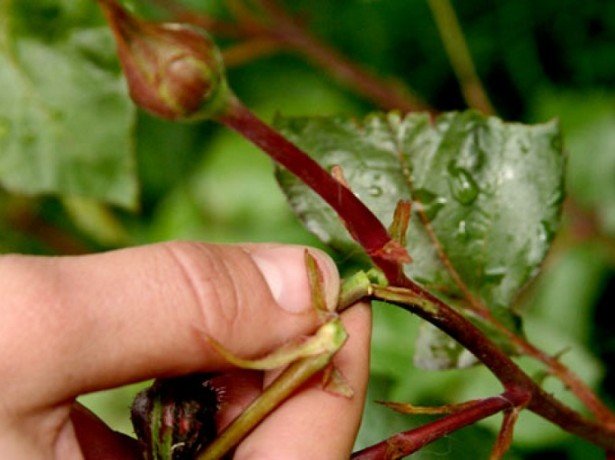
Rose care
During flowering
Florists sometimes ask a question on the flower growers' forums: why has Amadeus not blooming for several years? The reasons may be as follows:
- the plant is planted in the shade and lacks sunlight;
- the soil is depleted, there is not enough nutrients;
- the plant is attacked by insects;
- pruning of the bush has not been carried out for a long time.
If you analyze the condition of the plant and eliminate the found causes, then the rose can still have time to please with flowering this summer. Only during this, the main thing is not to weaken the care of the rose: you should water and feed with mineral and potash fertilizers, cut off dry buds, loosen the soil.
Florists note that the Amadeus climbing rose is one of the best. If you plant red Amadeus with white clematis, the combination will be unique. With timely watering and feeding, curly flowers will decorate the garden every year.
Top dressing
The humus added when planting in a hole feeds the rose for two years. Later, the plant will need fertilization. In the spring, it is necessary to apply manure, which will give a powerful impetus to the growth of young stems. It is not recommended to apply this organic fertilizer in autumn, because the overgrown shoots will not have time to get stronger and simply will not survive the winter.
For autumn feeding, the following compositions are suitable:
- potassium sulfate, potassium magnesium, sulfate, potassium chloride;
- double and simple superphosphate;
- slaked lime, dolomite flour, chalk, wood ash (formulations containing calcium).
During the growing season, the Amadeus rose must be fed 4-5 times. To feed the bushes with potassium, you can use the following solution:
- 10 liters of water;
- 16 g of potassium monophosphate;
- 15 g superphosphate.
In order for the roses to get the required amount of phosphate, you need to add 10 grams of magnesium sulfate to a bucket of water. For calcium feeding, you can use a solution of 1 spoonful of calcium nitrate diluted in ten liters of water.
How to properly plant a rose Amadeus in open ground
Rose Amadeus is unpretentious, but in order for it to develop well and please with lush flowering, you need to pay attention to the peculiarities of planting and care.
About planting time, site selection, soil
Roses can be planted in spring or fall. You need to choose a sunny area free of tall plantings. The thorny beauty loves loose, light soil. Lime will have to be added to clay soil. The site must be elevated, otherwise the root system will be constantly in the water and may rot.
Note! Gardeners advise finding an area that is not exposed to sunlight for several hours a day. The bush must be kept in a manganese solution for some time, and then a biostimulant
To prepare the mixture, you must take the following components:
The bush must be kept in a manganese solution for some time, and then a biostimulant. To prepare the mixture, you must take the following components:
- mullein;
- 2 tablets of phosphorobacterin;
- clay;
- a bucket of water.
The composition should be mixed and the rose should be lowered there. Immediately before planting, it is necessary to prepare a seedling: remove long shoots, cut roots and branches. When planting in autumn, the bush should be sprinkled with earth, making a small mound.
Planting procedure step by step
A rose bush is easy to plant if you follow the step-by-step instructions:
It is necessary to dig a hole in the shape of a square, the sides of which are half a meter, a depth of 50 cm.
The soil from the pit must be mixed with humus (compost), add sand.
A drainage layer is made at the bottom of the hole.
Part of the prepared soil composition is filled up.
The flower should be taken out of the biostimulator, placed in a hole and all roots should be spread.
The root system is gradually covered with soil and slightly compacted.
You need to pay attention to the vaccination, it should be just above ground level.
A near-trunk circle is formed.
The seedling should be watered abundantly and covered with a layer of mulch.
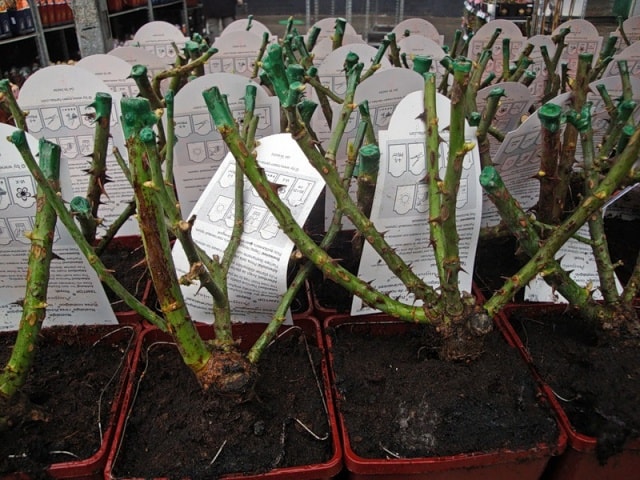
Planting a climbing rose
Preparation of seedlings
Before planting, the seedlings must be prepared - cut the roots, remove long shoots, pickle in a weak solution of potassium permanganate, sprinkle the buds with charcoal and then lower the bush into the biostimulant solution. It can be a mineral mixture consisting of mullein, clay, 2-3 tablets of phosphorobacterin per ten liters of water (or one tablet of heteroauxin).
After that, the seedling can be lowered into the hole. If planting is carried out in the fall, then the root collar should be covered with soil by ten centimeters. Otherwise, the rose may die in winter. After that, the soil is compacted and watered abundantly. The bush is cut off, stepping back from the surface of the soil about twenty centimeters. If planting is done in spring, the seedling is shortened to 15 cm.

How to prune bushes for the winter?
This procedure is carried out when the air cools the dominus of 5 degrees. This will give the plant an opportunity to strengthen and not freeze in winter. For the winter, you need to remove those branches, because of which the rose may suffer in winter. For example, healthy stems can become infected. Cut off shoots with black or brown spots, mold or rust. They also get rid of weakened and broken branches. In addition, faded inflorescences and not fallen leaves are removed. Leaving healthy shoots, they are cut to 30 cm from the ground. Pruning of branches should be carried out in early November, when plants begin to cover for the winter. Instruments prepared for trimming must first be well sharpened and sterile.
Varieties and photos
Blushing bride
Climbing rose variety capable of growing up to five meters. Flexible stems are covered with dense, dark green, healthy foliage. Flowers, white with a cream shade, are collected in lush inflorescences. Long-lasting flowering throughout the season.
The aroma is not pronounced, the plant has a high degree of disease resistance, great for decorating gazebos, arches, fences. Winters well under cover.
Alexandre girault
A climbing rose hybrid, reaching a height of 3.5 - 5 m. It has a small number of thorns. The foliage is glossy, dark green in color. Flowers, carmine-pink saturated shade, flowers have curved petals and reach 5-6 cm in diameter. Appearing in abundance on the bush, they fill the garden with a rich fruity aroma.
Due to its tallness, this variety is successfully used to decorate gazebos or any vertical surfaces. The plant has medium degree of stability disease and rain, tolerates shade, requires winter shelter.
Banksiae Banksiae
Belongs to the group of small-flowered climbing roses. It reaches a height of 4-7 meters, the shoots are flexible and practically devoid of thorns. The leaves are elongated, shiny. Early and abundant flowering.Small white-cream flowers with a characteristic violet scent, collected in large inflorescences. The plant is weakly hardy and needs good shelter.
Wartburg
The variety belongs to the group of multiflora hybrids. A vigorous bush has smooth shoots without thorns. Raspberry pink, small, double flowers, no more than 2 cm in diameter, collected in 35-40 pieces in large, inflorescences. Abundant flowering, one-time, for 25-30 days.
Heritage
One of the best and most popular English roses. A modern, hardy, re-flowering multi-hybrid.
The flowers are dense, heavy, pastel pink in color. The plant can reach one and a half meters in height. With proper care, the bush is almost not bare from below, expands upward and is quite spreading.
Lush foliage and elongated shoots are formed around the third year of the plant's life. The foliage is dark green, large, the shoots are practically devoid of thorns. The variety is resistant to precipitation, blooms only in sunny areas, does not tolerate even a light shade.
Mme alfred carriere
Belongs to the group of noisette roses. This old variety can grow up to five meters, has half-leafy, thornless shoots. Flowering begins early, throughout the season the plant pleases with large pale pink flowers with a delicate aroma. Poorly tolerates cold, requires very careful shelter for the winter (which varieties of roses do not require shelter?).
Maria Liesa
Tall variety, can reach three meters. The plant is powerful, with strong shoots practically without thorns. Leaves are dark green, small, pointed, glossy. Flowering is long, single.
Cup-shaped, double, crimson-pink flowers with a white center and yellow stamens are collected in inflorescences. The plant perfectly survives precipitation and frost down to -25 degrees.
Marie-jeanne
Belongs to the group of low polyanthus roses, the height of the plant does not exceed one meter. The bush is compact, practically without thorns. The foliage is dense, round, dark green in color. Small white flowers bloom in lush inflorescences at the ends of the shoots. The aroma is medium. The shrub is resistant to diseases, hibernates under cover.
Crimson Rambler
Differs in intensive growth, as a result of which, it is able to quickly braid surfaces. On average, the plant is 4 meters tall.
It is preferable to plant on the south side, but this variety will cope with partial shade.
The flowers are small, up to 5 cm in diameter, fiery carmine-red in color, collected in inflorescences of 40-50 pieces. Flowering is single, lasts a little more than a month. The plant is odorless. In the presence of shelter, it calmly tolerates frosts down to -30 degrees.
Coat of arms rose
Vigorous, up to four meters, a hybrid of a climbing rose, blooming throughout the season with bright pink fragrant flowers, collected in inflorescences of 3-5 pieces. Shoots with sparse thorns and dark green shiny leaves. The plant tolerates partial shade, has an average degree of resistance to rain and disease.
Paul Trenson
A fast growing rose with salmon pink flowers similar to pompons. The first wave of flowering is very abundant, after which individual flowers bloom throughout the season. The shoots are flexible, almost without thorns, covered with light green foliage. The plant can reach a height of three meters, endures partial shade, has an average degree of resistance to powdery mildew and black spot.
Preparing roses for winter
Already at the beginning of August, the application of nitrogen fertilizers to the soil stops. They are replaced by a strengthening podzimnya root dressing. It consists of:
- 25 g superphosphate;
- 2.5 g of boric acid (or 3.5 g of borax);
- 25 g superphosphate;
- 10 g of potassium sulfate per 10 liters of water.
This amount is sufficient for processing 4 m² of soil.
A month later, a second strengthening feeding is carried out, which can be replaced by spraying with the same solutions, but three times reduced concentration. Covering a bush is a must when preparing for winter. He needs high-quality thermal insulation.
Rose Amadeus can be covered in two ways: by leaving the whips in place or by removing them from the support.
In the second case, the shoots are removed from the stand, old and weak branches are removed, leaving only the 12 strongest shoots. Then they are tied and pressed to the soil, fixing with pegs, covered with spruce branches, and soil is poured onto the base. Then the entire structure is covered with a dense film.
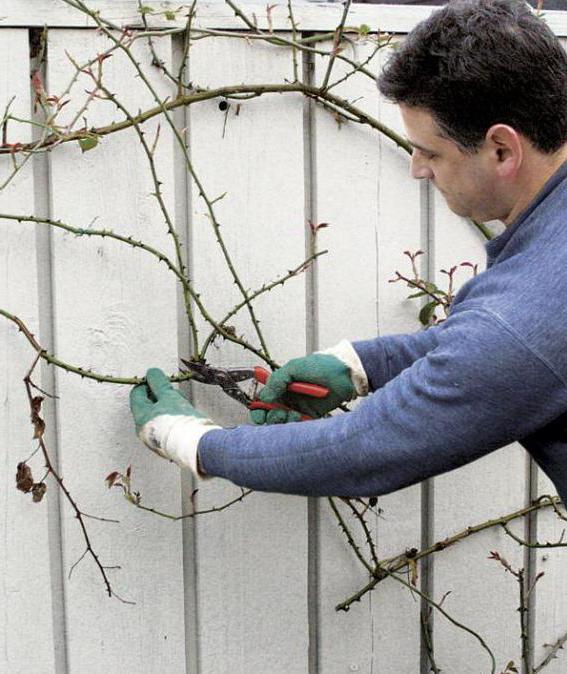
Care
Although the rose "Amadeus" is not capricious and demanding, it still needs care. Nothing complicated will need to be done, so even a novice gardener will find it easy to grow such a beauty on his site.


Care instructions are described below.
All roses love watering, Amadeus is no exception. Once a week will be enough, in dry weather the frequency of watering increases up to 2 times. For irrigation, it is advisable to use settled warm water.
Top dressing must be carried out in the spring and autumn in the second year after planting. Humus added to the pit during planting will feed the plant for 2 years. After this period, manure is added in the spring to stimulate the growth of new shoots. In autumn, potassium sulfate, superphosphate, dolomite flour, ash and chalk, lime (slaked) are introduced.
The bush needs pruning, which starts at an air temperature of -5 degrees. The secateurs must be disinfected and sharp. All shoots that show signs of the disease (spots, mold, rust), as well as weak, broken off branches, inflorescences, leaves, are subject to removal. Healthy branches are pruned 30 cm from the ground.
For a bush, it is advisable to think over the support in advance. Vertical stands are best, and you will need a lot of them, since the main shoots will release side branches.
The plant should be transplanted in autumn or early spring after thawing of the ground.
The bush must be dug out very carefully so that the root system is not damaged. Bad and small roots are cut with pruning shears
In the new pit, drainage and nutrient mix is being prepared. When transplanting, the plant must be carefully set in a new place and the roots should be spread. After a few days, you need to add soil under the bush, since there may be soil subsidence.
The rose needs shelter, especially in cold regions with frosty winters. It is necessary to provide high-quality thermal insulation. Shoots can be left on a support, or they can be removed, fixed near the ground, covered with spruce branches and a thick film. Even with light cover, the bush is able to withstand severe frosts at -30 degrees.
Sympathie
This variety is very popular among florists. It is a beautiful plant with large velvety flowers, usually deep red in color. Sympathy roses are light-loving flowers, so they are used in sunny and well-ventilated places.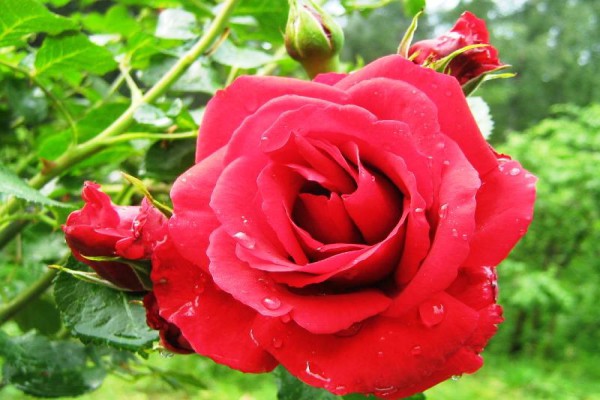
Their main feature is a pronounced, unique smell, as well as absolute moisture resistance. The flowers of these roses look very harmonious against the background of rich green leaves. The strongest flowering occurs almost always in early summer, after which flowers appear throughout the summer, but not so abundantly.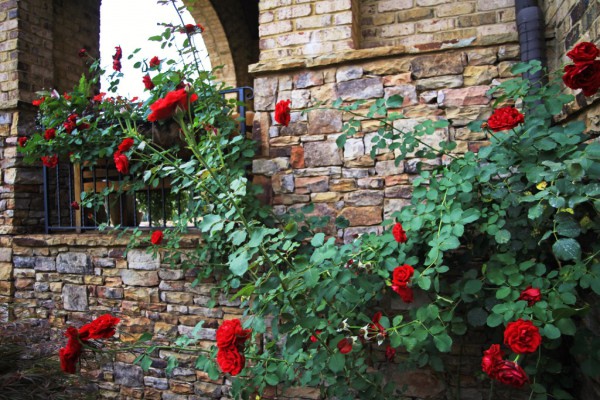
Interesting: in 1964 this variety of rose was awarded the German ADR certificate, attesting to their durability and reliability.
Advantages and disadvantages
Of the positive aspects, it is worth noting the following:
- decorativeness of the variety - the unusual beauty and shape of the climbing rose flowers attracts more and more fans;
- long and abundant flowering period;
- relative unpretentiousness and resistance to pests, which can appear only with extreme careless care of the plant.
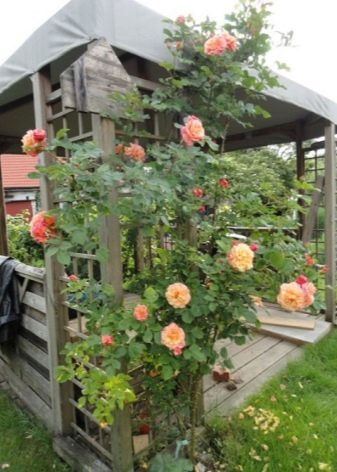
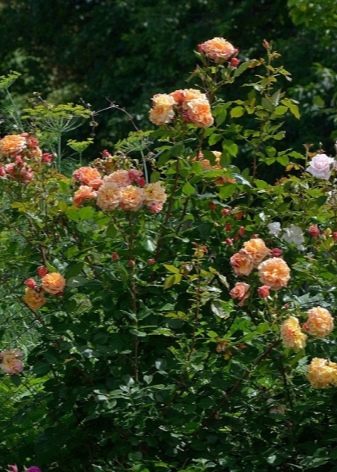
Among the negative aspects, the following should be noted:
- heavy inflorescences often sag to the ground, so "Aloha" really needs a solid support;
- the stems of the plant are covered with many thorns, which can cause inconvenience when leaving (pruning, transplanting, wrapping for the winter);
- this variety needs fertile soil, therefore it is necessary to fertilize it in a timely manner (at least once every 2-3 weeks).


